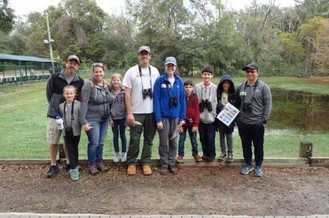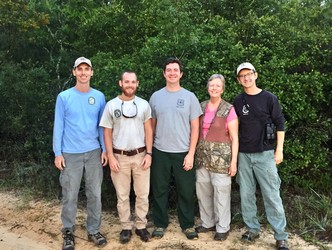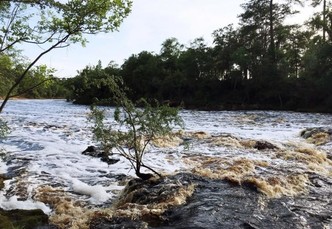 Tampa CBC for Kids participants smile after a successful day of birding! Photo by Jim McGinty
Many birders around the state and country like to participate in the annual Audubon-sponsored Christmas Bird Count. For the 119th CBC between Dec. 14, 2018 and Jan. 5, 2019, Jim McGinity of the Learning Gate Community School decided that it was time to enlist the help of the next generation of birders – children! He patterned the event after other “CBC for Kids” events previously held in California and Canada.
This first-time event coincided with the Tampa-area CBC on January 5, so the birds seen on the school’s 30-acre campus that morning were included in the official CBC total. After brief “Binocular 101” and “Bird Identification Basics” classes indoors, the kids headed outside with their parents, plus four expert birders to help identify anything they might see.
After an hour and a half of birding on campus, the group gathered to tally up the species. The group had spotted 28 species, with a total of 219 individual birds. And at the end of the event, the nine participating children also shared their favorite bird! The highlights of this CBC for Kids? Seeing and identifying Eastern Bluebirds, a Hermit Thrush and a very cooperative Eastern Towhee. According to some of the parents, the event also sparked an interest in birding for several children. Hopefully, the next Christmas Bird Count will attract many more young birders!
[Article by Jim McGinty, Learning Gate Community School]
 A color-banded Red-cockaded Woodpecker
The Red-cockaded Woodpecker (RCW), named for the tiny red streak high on the cheek of adult males, is a species of enormous conservation concern. These birds live and nest exclusively in open pine savannas – a habitat that has been threatened by logging, development and fire suppression. The population has declined by an average of 3.3 percent annually since 1966, leading to the listing of the woodpecker as a federally endangered species.
Roughly a quarter of all RCWs live in Florida, ranging from the state’s northern border all the way south to Big Cypress National Preserve. Biologists studying these birds often mark their nest trees with white bands of paint around the base, so keep your eyes peeled! You may even see some individuals with leg bands, used by scientists to track individual birds so they can record their movements and social interactions. In addition to closely monitoring RCWs to learn more about the species, FWC has implemented the Safe Harbor agreement, part of a national program incentivizing private landowners to maintain or restore habitat for these birds.
This past October, Hurricane Michael had a significant impact on RCWs in northwest Florida. Apalachicola National Forest, St. Marks National Wildlife Refuge and Tate’s Hell State Forest contain the largest single RCW demographic population in existence anywhere, with a total of approximately 916 active clusters pre-storm. Apalachicola National Forest, where most clusters are located, sustained the worst damage.
There still are many sites along the Great Florida Birding and Wildlife Trail that are great for viewing Red-cockaded Woodpeckers. Use our trip planner to find a site near you!
 FWC Volunteer Lois Posey with fellow volunteers and FWC staff
If you love Florida's wildlife, there are tons of ways to get involved in conservation action! We interviewed Lois Posey, who has been volunteering since 2016 with Florida Fish and Wildlife Conservation Commission (FWC) Florida Scrub-Jay projects, to find out what she loves about helping conserve wildlife. She has been involved as a volunteer in monitoring, banding and even translocating Florida Scrub-Jays alongside FWC biologists.
She had this to say about working with these birds, the only bird species unique to Florida: “Florida Scrub-Jays are birds loaded with personality. You can’t help but fall in love with them! They are beautiful and sociable birds that are fun to observe. Their behaviors are never predictable. Their scrub habitat is a harsh environment, filled with interesting creatures like gopher tortoises and scrub lizards, black bears and coyotes, beautiful wildflowers like the tarflower, Palafoxia and blue curls, and interesting insects like tiger beetles, rainbow scarabs and orb-weavers. Every visit to the scrub is rewarded with an interesting find of one sort or another.”
Thank you to Lois and all the other volunteers working hard to protect our native species and ecosystems! If you are interested in learning more about volunteering in your area, check out the volunteer page on FWC’s website!
 Rapids along the Suwannee River (Photo by FDEP)
Together, Big Shoals Wildlife Management Area, State Park and State Forest make up Big Shoals public lands, a stunning area of almost 4,000 acres bordering the Suwannee River in north Florida. This area is known for the largest whitewater rapids in Florida, as well as 80-foot high bluffs along the river offering incredible views. Thirty-three miles of trails wind through sandhills, hardwood hammocks and wet lowlands. The Big Shoals trail is recommended for birding, with species such as Hooded Warbler, Acadian Flycatcher and Black-crowned Night Heron. Brazilian free-tailed bats inhabit a bat house near the Big Shoals parking area!
In addition to wildlife viewing, adventurous visitors have ample opportunities for mountain biking and paddling. Safe paddling is dependent on river levels; call ahead for conditions.
Address: Little Shoals Entrance - 11330 S.E. County Road 135, or Big Shoals Entrance - 18738 Southeast 94th St., White Springs, FL 32096
Contact: (386) 397-4331
Hours: 8 a.m. until sundown
Fees: State Park: $4 per vehicle. SF and WMA: Free
February 3: Birding 101 at Fort Mose (St. Augustine)
February 4: Clearwater Audubon Society Meeting (Clearwater)
February 7-10: Birds of a Feather Festival (Palm Coast)
February 9: Three Sisters Springs Bird Walk (Crystal River)
February 15: Birding by Kayak (Silver Springs)
February 15: Orlando Wetlands Park Bird Walk (Christmas)
February 15–18: Great Backyard Bird Count (Your own backyard!)
February 16: Honeymoon Island State Park Bird Walk (Dunedin)
February 16: Caloosahatchee Creeks Preserve Guided Nature Walk (North Fort Myers)
February 16-18, daily: STA 5/6 Driving Bird Tour (Clewiston)
Feb 23: Florida Scrub-jay Festival (Merritt Island National Wildlife Refuge)
Check out the events page of our website for more events across the state!
Do you know about any other bird or wildlife-related events going on in Florida? Help spread the word by letting us know! Send in the times, dates, locations and contacts to wildlifeviewing@myfwc.com for posting on the Great Florida Birding and Wildlife Trail website.
Events must be related to birds or other wildlife and must be open to the public. Examples include interpretive programming, summer camps and family programs.
|